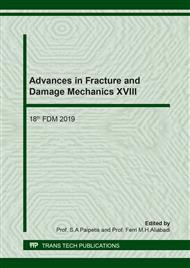p.252
p.258
p.263
p.269
p.275
p.282
p.288
p.294
p.300
An Influence of Cyclic Loading on Behaviour of a Hysteretic Interface Damage Model
Abstract:
A computational interface damage model which takes into account crack initiation andgrowth along connections between parts of a multi-domain structure is proposed and is exposed tosituations where cyclic loading and its effects on the structure are noticeable, though the inertial effects are not considered. Modelling of damage takes into account various aspects of damage propagation and invoking of an interface crack. First, the degradation function of the interface layer controls the stressseparation relation on damage evolution. Second, the instant of triggering and cessation of damage propagation may in situations of cyclic loads depend on the actual state of the structure, influencing thus its endurance limit. Finally, the hysteretic character of damage provides together with loadingunloading conditions a fatigue-like character, where the crack appears for smaller magnitude of the cyclic load than for pure uploading. The numerical solution and a short parametric study is provided for a simplified situation of single damageable interface spring.
Info:
Periodical:
Pages:
275-281
Citation:
Online since:
December 2019
Authors:
Price:
Сopyright:
© 2020 Trans Tech Publications Ltd. All Rights Reserved
Share:
Citation:


